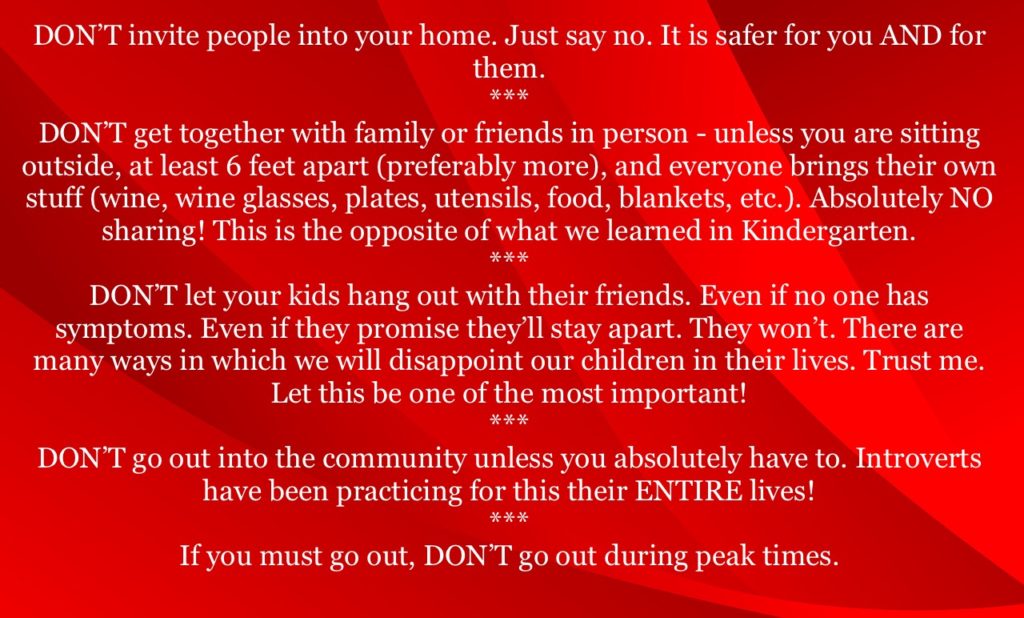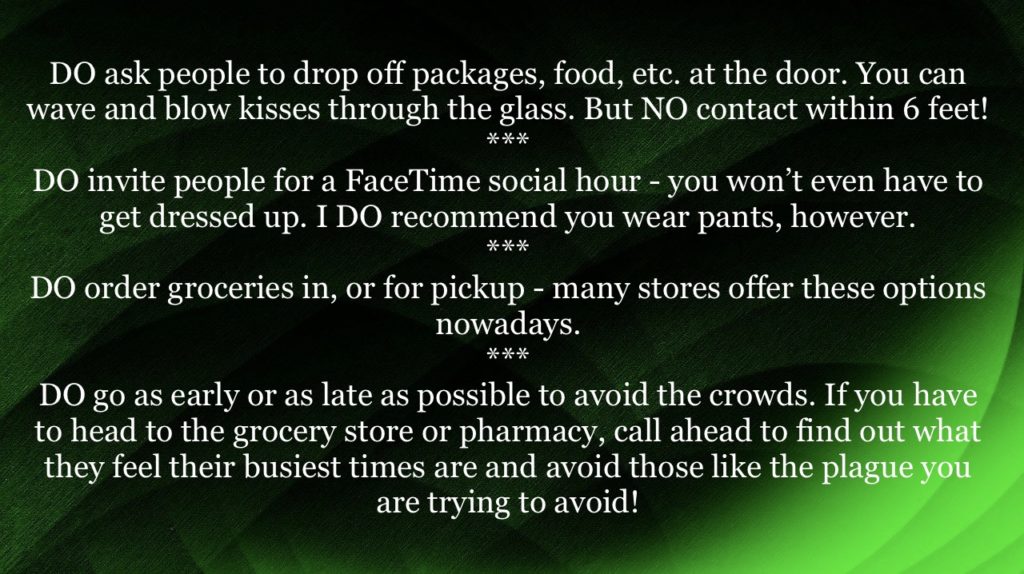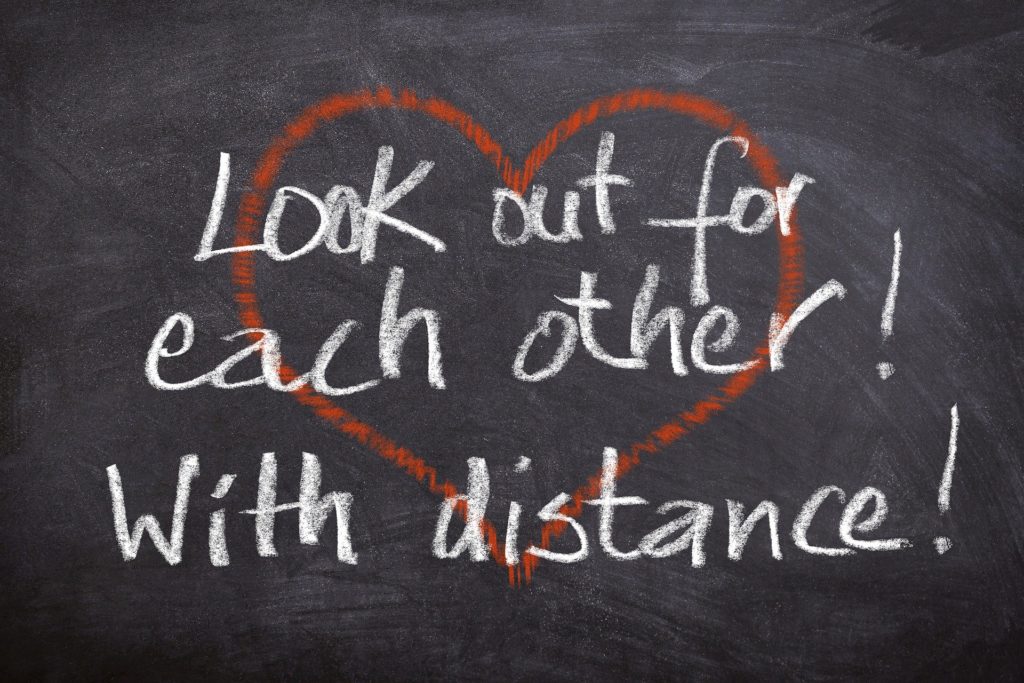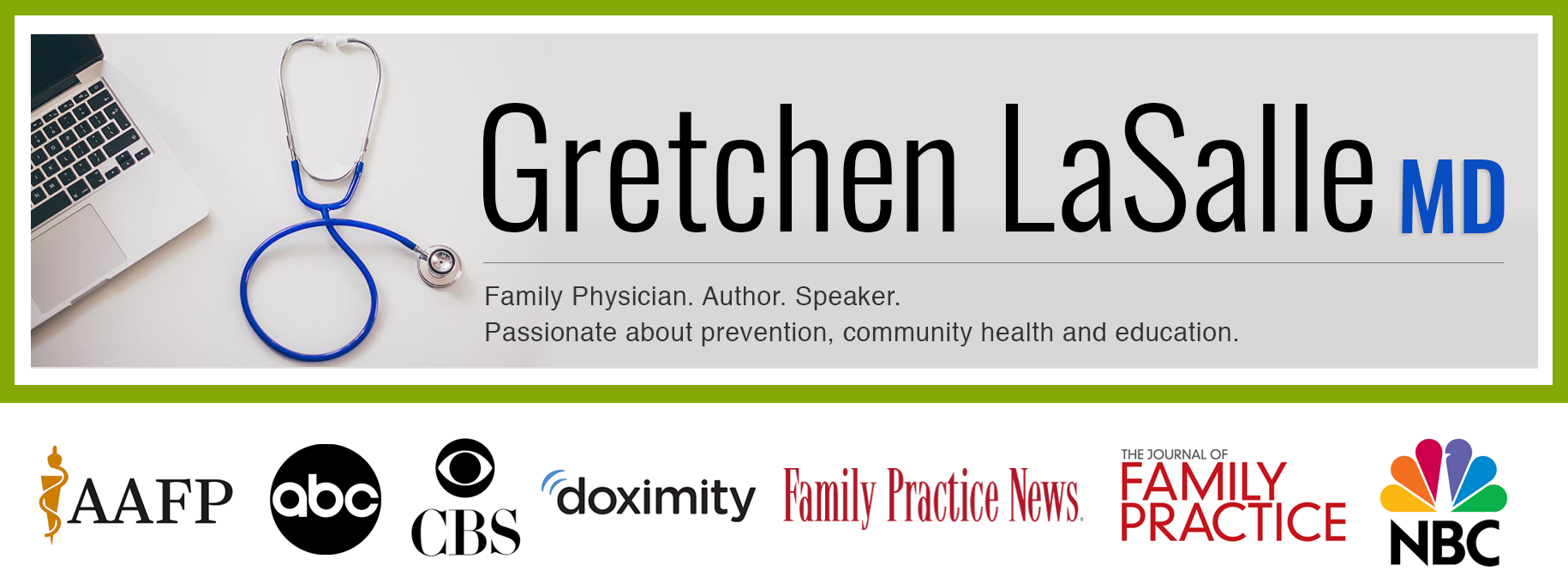Recently, it occurred to me that “social distancing” may be too nebulous of a term. Mostly it occurred to me because my friend Janelle told me it was too nebulous. So, I guess it occurred to Janelle. But then it occurred to me that she is absolutely right! So, there you go.
Obviously, some people are not catching the drift of what “social distancing” really means. Yes, I’m looking at you spring break college kids! So, today, we are going to give concrete examples of how you can distance yourself from others. And I’m not talking about ticking everyone off or not taking a shower for a week, though those things would certainly do the trick.
We’re actually not even talking about being unsocial. We need to be social for our physical and mental health. This whole Coronavirus Pandemic would be much less tolerable (not that it’s currently a basket of kittens) if we had to be completely isolated from the world. Lucky for us, we can connect like never before through the use of Tweets, posts, messaging, texts, emails, and video chats. Oh, and there’s also that thing called a telephone. Your kids may not know what that is. In fact, when this is all over, we may be even better at keeping in touch than we were before this virus changed life forever. We’re talking about putting physical distance between us and others.
Social distancing is just one of the “Big Three” ways we can protect ourselves and others in this pandemic. So, we’ll also review ideas to help minimize putting our hands on our faces, since that is the primary way that germs make their way into our bodies. And, we’ll review how we can lessen the risk of transmission from surfaces, as that is how the germs get to our hands in the first place! Hopefully, when this post is all said and done, you will feel less fear and greater confidence that YOU have the power to control your risk.
Social Distancing – Why is it necessary?
It is necessary because we have NO treatment and NO vaccine for this illness. It is entirely new to humankind. We have no immune memory to help us fight it off. The only way we are going to stop this thing is to stay away from each other. It’s that simple.
In an ideal world (and our world is far from ideal) we would have diagnostic tests so we could test everyone early, even before the onset of symptoms, and know who needs to isolate. And, because a large percentage of illnesses will be asymptomatic or only minimally symptomatic, something we might chock up to the common cold, we’d have antibody tests so we could test everyone to see if they were already immune. Those folks could then get back to work to help bolster our economy and give reprieve to those or are ill or caring for ill loved-ones.
Obviously, within our own households, we can’t always maintain a 6 foot distance. Though, I will tell you that there are many doctors and nurses out there who are physically separating themselves from their families (in different parts of the house, in campers, in hotel rooms) so they don’t run the risk of spreading the virus to their loved ones. However, most are not as high-risk as medical professionals. It is very reasonable for your average-risk person to go about normal spacing in their own home. BUT, it is also prudent not to borrow trouble. For example, kissing. Probably this should be off limits for now.
So, apart from in our own homes, what does social distancing mean? It means the following…
The DON’Ts of Social Distancing

The DOs of Social Distancing

How about avoiding face touching? How do we do that?
This is tough, people. I feel your pain. As soon as someone tells me I can’t touch my face, EVERYTHING itches! And kids are the worst, constantly sticking their fingers in their noses and mouths. We need to help ourselves, and our kids, develop some non-face touching habits. Here are some things we can try.
1. Start a non-sedating antihistamine (Claritin, Zyrtec, Allegra or their generics). If you have allergies, which are commonly flaring this time of year, this will help control the itch and lessen the risk of eye rubbing and sneezing.
2. Cut nails super short. Though, no need to induce bleeding. Really short nails offer nothing to bite!
3. Stop nail biting and thumb sucking. There are over-the-counter products (like Thum and Orly No Bite) that you can paint on to help break these habits.
4. Embrace the hair pulled back look. For us ladies, a common cause of touching our faces is moving hair out of the way. Get hair out of your face by putting it in a ponytail or braid. Also, Tyra Banks from America’s Next Top Model swears that this makes everyone look younger. So, there’s that!
5. If you must touch your face, do it with a tissue (or the sleeve of your shirt, if you’re in a pinch) so no direct hand-to-face contact is happening. Then wash your hands immediately, just in case!
And what about the surfaces? There are so many surfaces!
We’ve discussed the word “fomite” before but let’s talk about it again. “Fomite” is a medical term that describes any object or material which can carry infection – like clothes, utensils, furniture, countertops, etc. High touch surfaces are the most likely fomites and we should be minimizing touching these as much as possible, as well as cleaning them as frequently as possible. Also, now that we know that SARS-CoV-2 can last on hard surfaces for 72 hours and on more porous surfaces for 24 hours, we need to be more vigilant about routine cleansing of really anything we touch. Here are some specific ideas of ways you can attend to all the fomites in your world.
1. Stop wearing rings, bracelets, and watches. These things are not easy to wash and germs can easily hide on or under them.
2. Get rid of the kitchen and bath hand towels. Use single use washcloths or paper towels/napkins instead. While my husband and I are trained in the surgical scrub manner of hand washing, my children are much less vigilant. And I am not there to monitor their every wash. I can’t trust that they are doing a thorough enough job. If they then dry with a towel, then I use that same towel, it could expose me to infection.
3. Take trash cans out of cabinets. Every time you have to touch a handle to open a cabinet it increases the risk of transmission. If the trash can is sitting out in the open, then that single use napkin can go straight into the trash without a middle man.
4. Clean railings, knobs, and handles (toilet, sinks, cabinets, refrigerator, microwave, dishwasher, doors, etc.) frequently. What does frequently mean? Well, I’d aim for EVERY SINGLE DAY.
5. Clean kitchen and bathroom countertops frequently. By the way, I would encourage you to engage some child labor and teach your kids how to clean the house. It takes the pressure off of you and it teaches them valuable life skills. Just make sure they go from sink to toilet, not toilet to sink. EW!
6. Keep sanitizing wipes or hand sanitizer in your car and wipe down the door handles, lock and unlock buttons, window buttons, steering wheel, and gear shift often. Definitely sanitize after getting gas or being at the grocery store or, really, after being anywhere outside of your car.
7. Set up a decontamination station to be used before anyone enters the house. This can be as simple as a STOP sign on the garage door with a bottle of hand sanitizer next to it. Or it can be as complex (medical folks may need the more complex) as having a place to sanitize hands, phone, and keys; a place to take off work clothes and shoes and change into “safe” clothes before entering the house (unless you want to run through the house in your birthday suit); and a direct line to a shower to wash off any germs from skin and hair that may have made their way home from work.
8. Sanitize your phone often – so many germs!
9. Put reminders EVERYWHERE – On bathroom mirrors, on the refrigerator door, etc. We all need as much help remembering to sanitize as we can get.

Image from Pixabay
10. Wipe food containers down with disinfectant after grocery shopping or ordering takeout. Wash fruits and vegetables before eating, as usual. Who knows how many people have touched those containers or that food before you did?
11. Wash hands BEFORE MAKING food. Wash hands BEFORE EATING food. Wash hands AFTER EATING food. We wash before to protect ourselves from germs. We wash after to protect everyone else. You know you just accidentally licked the ketchup off your finger and your kids are eating their salad with their hands. Or maybe that’s just me and my kids. Nonetheless, before and after eating are high risk times for transmitting germs.
12. Give those who are sick their own space. Those who have tested positive for COVID-19 or are suspected of having COVID-19, need a separate bedroom and bathroom that no one else uses. They should receive food on disposable plates with disposable utensils, and drink from disposable cups, as no one else in the family should have to wash items from which they’ve eaten. They will need their own thermometer, their own medications to reduce fever, and their own technology to keep in contact with family and friends.
Our sick family members should be able to exist in their bubble for at least two weeks without having direct contact with anyone else. I recognize that all bets are off if it is a young child who is sick. But the above recommendations should be followed as closely as possible for everyone else.
What’s the latest?
There hasn’t been much that is new in the last week. We continue to see a rise in cases and deaths. Pleas from medical professionals, asking for help in getting the ventilators and PPE they need to care for patients and self, persist and grow louder. We still don’t have enough tests. We don’t yet have reliable treatments for this virus or a vaccine to prevent it – though scientists and doctors are working around the clock to find and develop them. Wonderful, inventive people are looking at ways of repurposing hospital materials to create masks, since none are being provided. Desperate doctors and nurses are looking at ways to jigger our existing ventilators to make one machine work for two or more people.
Amazingly, there are some out there who still insist that this crisis is overblown, that it’s not going to be as big of a deal as we say it is. Are they watching the news? Are they hearing of the hospital workers who are dying and the refrigerator trucks that are being used to store patients’ bodies, as there is no where else to keep them? If you know any of these people, please try to talk some sense into them.
Until we have the tests, the treatments, and the vaccine we need to help contain this monster, it is up to every individual to help us win this war. We can’t afford to downplay the situation. We MUST keep our physical distance. Every person’s actions matter! Every person has the power to save a life, if they choose to do so.

Image from Pixabay
Stay vigilant everyone! Let’s come together by staying apart!


Thanks for the great article Dr. LaSalle. In our family every time someone touches their face they have to do 5 push-ups. It has turned into a fun game.
Oooh, I love this idea! Borrowing! Stay safe, Sara.
Love your blog, Dr. LaSalle! It is so informative and so well-written and witty. Makes me feel like I’m having a private office visit with you. Thank you! Quick question. If one is home alone and not going out, must one still wash hands so frequently and also wipe down surfaces constantly?
Hi Jody! Thanks for your kind words. It really depends on if you live alone or not. If it is just you and no one else then it is probably not as important. However, I would make sure that you do it periodically and, for sure, before you enter your house. Get those hands super well sanitized so that you aren’t bringing germs from the world into your home. I keep a bottle of hand sanitizer in the garage so I can sanitize before touching the door to the house. If there is anyone else in your house, then the answer is yes – you still need to wipe down surfaces frequently.
I am most certainly an iconoclast, maybe I am right, maybe I am very wrong. At this time we do not have a vaccine for a virus we have not previously seen before. However, it is my understanding that youngsters, high school aged youths, and young adults rarely suffer grievously from this disease. In fact, I have spoken with family members who told me that their young adults and active children got the disease and bounced back without a hitch. When I was born the population of the world was 2.7 billion souls. Now it is 7.3 billion. There is an endpoint of human population growth at which time nature will ferociously winnow the population. No population can grow forever, with an infinite number of citizens. Obviously, viewing human behavior and a powerful innate desire to conquer disease to increase the human population, it is necessary that we learn as much as we are able, and modify the human species to enable space travel for long, long time periods to colonize distant planets. However, there cannot be an infinite human growth and there will inevitably be a massive die-off, hopefully after we have sent our best and brightest to conquer the long darkness to land upon a new land to conquer. Nature will winnow our population for us if we do not have the awareness to take care of it ourselves. I prefer voluntary awareness rather than war or disease.
Nature taking her revenge? I have to admit the idea has crossed my mind.